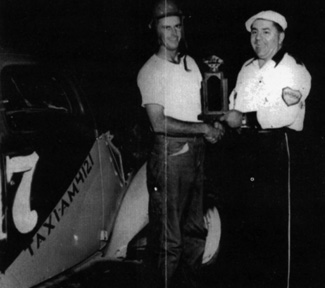
Jack Etheridge accepts the trophy and a handshake for a win at Atlanta's Peach Bowl in 1951.
By Eddie Samples
Posted in Feature Stories 7/23/10
Jack Etheridge was a Georgia native, and lived in Mableton, Georgia, just west of Atlanta. Jack was married to his wife, Roma, for 65 years before his passing in 2000.
Jack had an interesting life, which included 20 years as a race car driver. He retired from behind the wheel in 1954, saying he felt it was time to find a real job.
He and Roma married in 1935. At the time he was a WPA foreman making about $12.50 cents a week. He also dove a greyhound bus and was an executive for the City of Atlanta.
Jack even played some professional football before he became a racer.
Jack’s daughter served as an assistant district attorney in Maryland. His son worked as an advertising executive in New York City. His grandson was a pro wrestler.
Back in 1998, we stopped by his house to chat for a while.
GRH: When did you start racing?
JE: Best I can recall it was either in 1932, 33 or 34. Generally started racing sprints. After the war, stocks mostly.
GRH: Tell us a little about those pre-war days.
JE: Well, as a kid I would go to Lakewood Speedway in Atlanta and watch them race. I fell in love with it and would just about do anything to drive one. Met a man named A.G. Weldon from Oxford, Alabama, and ran his car for a while. Red Byron drove it some. I won a few races in it (Editor’s note: That car still exists today). Raymond Parks had Red Vogt fix up a car owned by Gilbert Daniels. He owned a garage at Bankhead and Hightower Road. AAA sanctioned a race at Lakewood with Ted Horn and all the big names. This little ole car did good and Daniels sold it on the spot for $700.
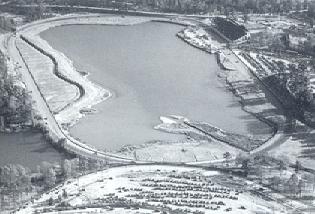
Atlanta's Lakewood Speedway was where Jack Etheridge would fall in love with racing.
GRH: Speaking of Raymond Parks, did you ever drive for him?
JE: I drove a midget at Lakewood for him once. I finished second. Red Vogt built it too. His regular drivers, Bob Flock and Red Byron, had no interest in driving it. That car really flew just to have a Ford engine in it. Beat a many Offy’s that day.
GRH: Offenhausers were the class of the day?
JE: Pretty much so. The Ford engines would wind up pretty good though. I drove a sprint once for some patrolmen. The car had a six cylinder Curtis airplane engine cut down to a four cylinder, but weighed too much on the front end, couldn’t do much with it.
GRH: Ever have any bad wrecks in those kinds of cars?
JE: Not really. But I don’t know how. Those cars had no protection. I remember once at Lakewood my front wheel had dug in too deep there close to the grandstand and the car kept rolling and rolling, but somehow never hurt me.
GRH: Many people come to those races?
JE: There would be a crowd of 20,000 or so all the way around that mile track. Promoter Sam Nunis would always put on a good show. I remember once for a pre-race exhibition he had a ramp built out in the grandstands and this guy on a motorcycle left that thing going full speed and landed in the lake. Some show.
GRH: So Red Byron drove Indy type cars?
JE: Yeah, he fooled around with them over at Vogt’s Garage. Back in the 1930s, those things were two seaters and the mechanics would ride with them. I know in the 1940s Byron went to Indianapolis a couple of times but never could qualify.
GRH: How would you compare the midgets or sprints to the stock cars?

While mostly known today for his stock car racing achievements, Red Byron was also an accomplished open wheel racer. Photo courtesy GARHOFA
JE: I don’t know, racing is racing. But I will tell you with the sprints you had to be on your toes. I mean, like at Lakewood going around at 125 mph with that little steering wheel. It would wear you out mentally and physically. Once I drove a midget for a couple of aviators, I can’t remember their names. But it was on the little quarter mile track at Lakewood in front of the grandstand. It was a night race and I ran a few slow laps then gunned it to qualify. Well, I had no brakes. I kept going straight…through the darkness and luckily was able to stop halfway down the backstretch of the mile track. That car didn’t have a chop (kill) button and I couldn’t find the ignition switch. Lucky I didn’t end up in the lake.
GRH: Let’s talk about the stock car part of your career. What do you remember about starting in stocks?
JE: I grew up with a bunch of guys in Atlanta. I raced for Airline Auto Service over on Spring Street some of the time. A bunch of us guys would be there or over at Red Vogt’s Garage on West Marietta Street. All the trippers and drivers and mechanics had some link with both places. They always worked on tripping cars at Vogt’s and it just overflowed over to Airline. Trippers and racers were in those days much one and the same.
GRH: Who exactly did you drive for?
JE: Claude and Roy Alexander. They had a shirt factory in East Point, Georgia, and a diary in Rex, Georgia. Wayne Sanders was a cousin of theirs and had Airline. Wayne was raised around the Grove Park area of Atlanta with me.
GRH: What exactly is “tripping?”
JE: You know what tripping is. Liquor was made in the mountains and transported to the city. The trippers provided the transportation.
GRH: Who were the trippers?
JE: There was a bunch of them. Way of life for most of those race drivers from around here. Just about everybody was involved in some form. You had your captains, sergeants and lieutenants. Thing was organized like the army.
GRH: What was the best car for tripping?
JE: I was talking to Raymond Parks the other day and we both agreed it was hard to beat a ’32 Ford. It would carry 125 gallons at 8 lb. per gallon real good. Best trip car there was in my mind.
GHR: I always had the image of those “trippers” as Robert Mitchum in the movie “Thunder Road”.
JE: Trippers usually came out a lot better when they would fill up their cars in the mornings and blend in with morning traffic going into Atlanta. You would be surprised at how many cars came to Atlanta in the mornings even back then. They call it sneak traffic.
Anyway, everybody knows if you are carrying half a ton of liquor in your car and somebody got after you the advantage is theirs. Of course a lot of times if they got after you, just ditch the car and head for the woods and have someone pick you up. The main road to Atlanta was Highway 19, but sometimes it got too “hot” and you would by-pass to Gainesville and come down Highway 23.
GRH: Who was the best tripper?
JE: I would have to say Legs Law. He was Raymond Parks brother-in-law. I never knew a man that could drive a street car in those circumstances better than Legs. But on the other hand, he was about the worst at driving a race car. He just never could make the changeover.
GRH: Somehow we got off of racing. Tell me the scariest moment you had in racing?
JE: You mean the day I talked to the Lord.
GRH: Okay.
JE: It was in a race in Orlando, Florida. I was on the pole and Roy Hall was on the outside. Every lap he kept pushing me further in towards the fence until finally he pushed me through the fence and out in a lake I didn’t even know was there. When the car finally hit the water it felt like concrete. The car went sinking to the bottom. The lake was at least 30 feet deep. The windows were p and I had on leather gloves and couldn’t unbuckle my safety belt, which was a holding back strap for a mule with a big iron hook. I was in trouble. I asked the good Lord to help me and he told me how. I made it to the top about the time the divers were entering the water.
GRH: What became of the car?
JE: The divers hooked a long cable to it and a wrecker winched it right out. The car was sitting outside a motel the next morning and there must have been 10 or 12 crawfish that crawled out of it.
GRH: Did Roy Hall say he was sorry?
JE: Yeah, but you know a professional driver knows what he was doing. And Roy was a pro. He seemed to spend more time in jail than on the track, but regardless, he could drive a race car.
GRH: Did you have any other “incidents” like that?
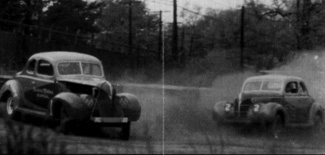
Jack Etheridge's car goes for a ride after being clipped by Red Byron at Lakewood Speedway on April 20, 1947.
JE: One time at Lakewood (April 20, 1947), I had the pole with a new record (his 49.5 seconds had just beaten Red Byron’s 49.8 set a few minutes earlier). In one of the heat races, Byron flipped my car over. There never was a feature ran because of rain and Red got first place money because I could not line up on the pole.
GHR: You think he meant to wreck you?
JE: I don’t know. He was a professional just like me and we both knew where we “let off” going into the turn. He hit me then told me he hit me again and I turned over. He said he was trying to “straighten me out.” Regardless, that “straighten me out” part ended my day.
GRH: Did you ever wreck anybody?
JE: Once in South Carolina Ed Samples and I were somewhere. He qualified in front of me and during the race I rammed him pretty good. After the race I walked him back to my car to prove my brakes had went out.
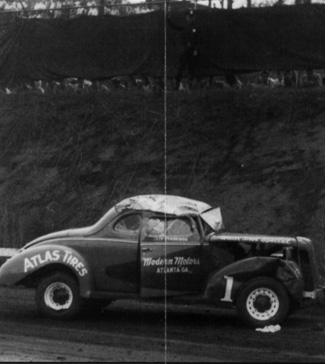
GRH: Any other incidents you remember?
JE: Nothing in particular. Some wrecks are really accidents and some are not. Sometimes a driver does what the owner of the car tells him to do or take the chance of losing his ride. I remember one time Buck Baker got mad at Jack Smith for something and hit him in the head with his helmet. You could hear it all over the track. I forgot what Jack did to him. You’ll need to ask Jack. But sometimes we were like a bunch of wild kids out there. We would do something like that, and then five minutes later it was forgotten.
GRH: How did you enjoy the Peach Bowl Reunion this year?
JE: Lot of fun. Jack Jackson has a good thing with that deal. I met people I hadn’t seen in a while.
GHR: Like who?
JE: I saw Bad Eye Shirley. He and Raymond Parks go back. Bad Eye never was much on driving a race car, but back in the early thirties at Macmillan Grocery store over off Chestnut and Kennedy Streets in Atlanta they needed a boy with a bike and basket. Mr. Macmillan had about 10 of those boys in a race around there and Bad Eye won. He never raced cars but he could sure ride a bike. I also got to see Billy Watson. Hadn’t seen him in years. Back in the 40s he was just a little skinny kid about the size of a pencil. Just a nice kid that liked racing. I remember Lee Morgan who was tripping and racing carried him to a race in South Georgia. He put Billy in a car and nearly got away with it. I don’t guess Billy was but about 14.
GRH: Returning to 1947, you should have won the winter race in Daytona. What happened?
JE: Ed Samples had the fastest car there. When he blew I knew then nothing could touch me. I was determined to lap the field but then I blew up.
GRH: Why didn’t you slow down?
JE: Ego, I guess. The car belonged to Modern Motors owned by Louis Brooks over on West Peachtree Street in Atlanta. We drove the car from Atlanta to Daytona showing off all over town. That probabably didn’t help us any. I remember Brooks before the race said take his wife and scare the hell out of her. I wasn’t for it but we got going about 115 down the beach and spun it about four times. The woman fainted and I thought I had killed her. I never did that again.
GRH: Speaking of women, who was the best woman driver?
JE: There were some pretty good women drivers. Ethel Flock and Sara Christian were good drivers. I guess the best was Louise Smith. She and her husband ran a parts place in Greenville, South Carolina and also ran the speedway there. She was a strong woman. She could hold her own.
GRH: Where did you enjoy racing the most?
JE: I don’t really know. They were all right I guess. They were all dusty. I remember one track in North Carolina I had been invited to race and they had me a room and a quart of moonshine beside the bed. Nice people.
GRH: You told me your scariest moment, how about our saddest in racing?
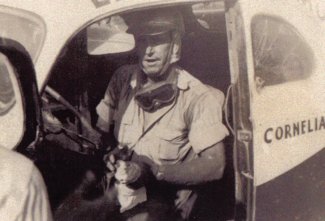
Jack Etheridge inside the cockpit of the Jack Edwards owned racer he piloted in 1948.
JE: I guess one would be the day Charlie Marks got ran over in Greenwood, South Carolina. It was a Saturday afternoon race in October of 1948. It was so dusty and I could see his car wreck and go on the outside of the track so we naturally went inside. With the dust you couldn’t see but I think several of us ran over him. He had been thrown from his car after his belt broke and he was crawling. We thought he was in his car. I will never forget it. We were to race that night in Columbia, South Carolina. I told Jack Edwards, the car owner, to find somebody else. I just didn’t have the stomach for it. I guess the other time was Skimp Hersey at Lakewood in 1950. We sometimes carried extra gas, or alcohol in a 55 gallon drum in the back seat of the racer. For whatever reason his car caught on fire and he flipped it trying to put it out. He tried to crawl out of the fire. A newspaper man grabbed his leg but the skin came off and he just didn’t make it.
GRH: Okay, any lighter moments you recall?
JE: I remember for a race at Lakewood one time a couple of fellows rented some new tires for a day from a service station. You could rent tires during that time. They didn’t make racing tires back then. Anyway, after the race they tried to carry them back. I remember the attendant hollered, “these ain’t my damn tires.” Anyway, they had to pay for them.
And I remember Bob Flock and his wife Ruby. He was the quietest of the Flocks. Whereas Tim and Fonty could talk you out of your false teeth, Bob was always easy going. I remember Bob went out of town one weekend for some races and when he came back Ruby had had a baby and he didn’t even know she was pregnant.
I remember once I had gone to Birmingham in the early fifties and Ruby and Bob went to watch (he had been in a serious racing wreck earlier). I had flown over with Ed Samples in his plane but Ruby asked if I would drive them back to Atlanta. I did. I was going the speed limit and Ruby kept complaining and finally she pulled out several hundred dollars out of her bra and said to step on it, she would pay the fine. She really kept Bob a-hopping.
GRH: Most embarrassing moment in racing?
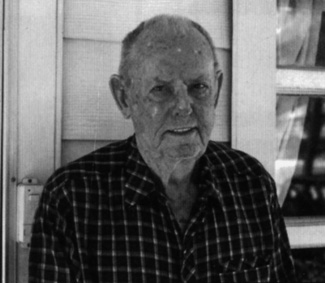
Jack Etheridge in 1998, at the time of this interview.
JE: Probably right after I won a stock car race at Lakewood. I think it was in 1948 or ’49. Anyway, I had just crossed the finish line and I was trying to unbuckle my safety belt and the front tire blew. I wasn’t going over 10 mph. The car just slowly slid over an embankment and landed on its roof. I undid my belt and hit my head on the roof. I had the best set of Firestone tires you could buy. After that, we cut a hole in the floorboard so as to watch the tires during the race.
Another time we were racing in Oxford, Alabama. I had a ’32 Ford and was late getting there so I had to start in the back. Anyway, with all the dust we followed each other down the backstretch and I thought a tornado had touched down. Come to find out we had left the track and were racing through a cornfield. You just couldn’t see where you were going.
GRH: I guess driving would be easier now?
JE: Sure it is. Asphalt and not dirt. Racing tires, power brakes, power steering. I might just start racing again. I could start with those Legends cars and go from there. What do you think, Roma (calling to his wife)?
Roma: Hmmm….
Editor’s note: This interview was originally published in the May 1998 edition of the Pioneer Pages magazine. Jack Etheridge passed away two years after this interview was done, on August 9, 2000. Later this year, he will be inducted into the Georgia Racing Hall of Fame.
Eddie Samples is a racing historian and writer, and is the son of champion stock car racer and Georgia Racing Hall of Famer Ed Samples.
Questions, comments, suggestions? Email us!
This website is not affiliated with or endorsed by the Georgia Racing Hall of Fame or the Georgia Auto Racing Hall of Fame Association, Inc. All content is the intellectual property of the individual authors. All opinions are those of the individual authors. Please do not repost images or text without permission.
